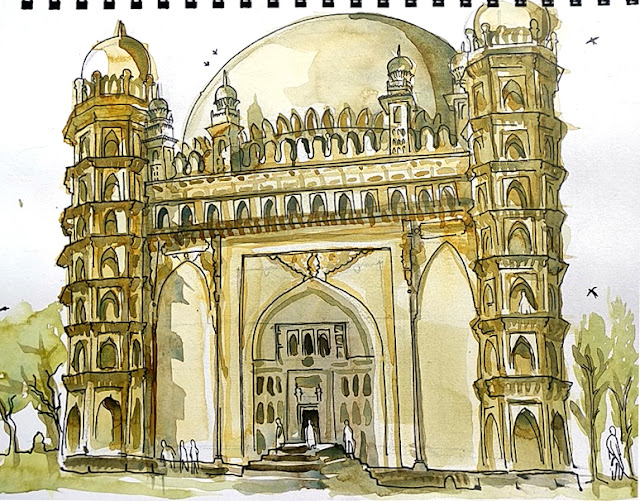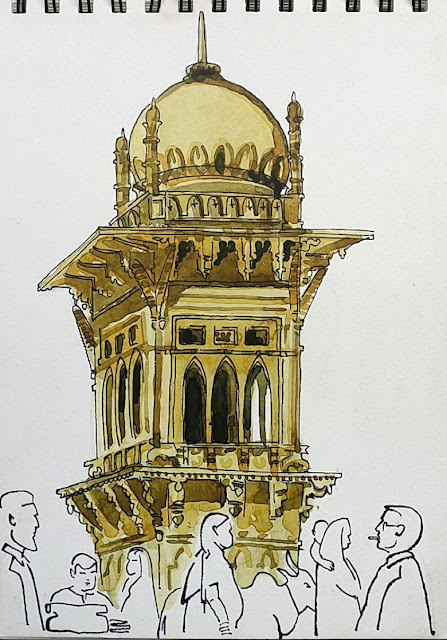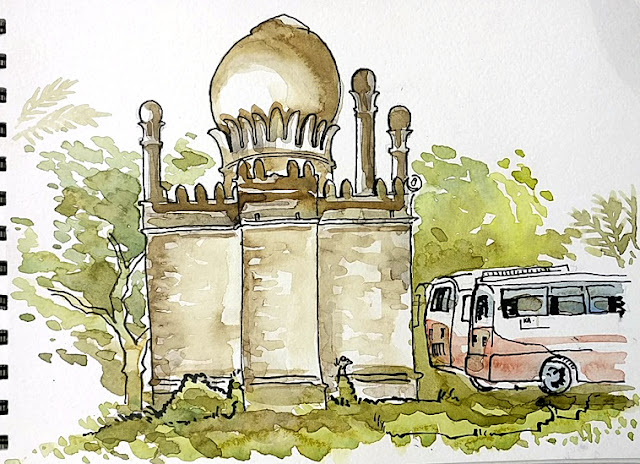
[Guest Post by Mohini Bariya in Bijapur] During the winter holidays, I made a trip to Bijapur, a town on the high Deccan plateau in southern India. Bijapur sits in a landscape of pomegranate orchards and millet fields. Even the center of town, with its dust, traffic, and construction, has an agrarian feel. Farmers in yellow turbans wait at the bus stop and freshly harvested sugar cane lies stacked on street corners. A feeling of distance clings to the town—the goods trucks lumbering down Bijapur’s main road do not seem to stop, but only to pass through on their way elsewhere.
Yet in the 15th-17th century, Bijapur was the capital of the wealthy Adil Shahi dynasty, and became such a cultural center that it was called the “Palmyra of the Deccan”. The Adil Shahi sultans were prolific builders, and their exquisite mosques, tombs and palaces still dot the city. The buildings are constructed from dark stone, and they have both graceful profiles from afar and astonishing detail up-close. Perfect for sketching!
To begin, I drew the Gol Gumbaz, (above) Bijapur’s most iconic monument. It is the mausoleum of Sultan Mohammed Adil Shah, and possesses one of the largest freestanding domes in the world. Its lovely grounds are full of huge shade trees alive with parakeets, barbets and hoopoes.
Next was the Jal Mandir, a small pavilion in a dried up pond that sits beside a busy market street.

Towards the edge of town, I drew an old mosque in a grassy field. The muezzin was cheerful and chatty. In the space of a few minutes, he narrated his life’s story, told of his love for cricket, and informed me that the public buses parked beside the mosque were purchased from the government by a local businessman who took them apart for scrap.

History can often feel remote and static and even the most beautiful ruins sometimes seem shrouded in gloom. Yet the Bijapuris have embraced the Adil Shahi’s work into their daily lives. One of the palaces is now a bustling government office, an old stable is a tea stall filled with chatting friends, the mosques continue to sound the call to prayer, and the landscaped grounds of the Gol Gumbaz are a place to picnic and take a morning walk. This might seem pure horror to a conservationist, but the people give the old monuments a vitality that I found both uplifting and poignant.
Mohini Bariya is currently a PhD student in electrical engineering at the University of California, Berkeley. Her research focuses on data analytics for the electric grid. She loves to sketch when she can, especially at home in India. You can see more of her sketches on this blog.
Share
Recent Posts
Drawing Attention June 2024
Drawing Attention, the official zine of the Urban Sketchers organization, communicates...
Read MoreVolunteer Opportunity: Urban Sketchers Seeks Fundraising Director
HOME Are you passionate about art and fostering a global artistic community?...
Read MoreThe USk Regional Events Grant Funding Programme 2024 / 2025
Season three of the USk Regional Events Grant Funding Programme is...
Read MoreCheck Out the Brand New USk Shop
Guess what? Our Urban Sketchers Shop just leveled up with some seriously...
Read More